
French literature of the 18th century
Encyclopedia
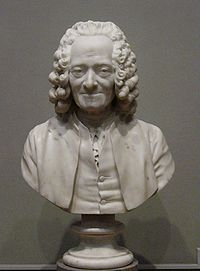
.jpg)
French Revolution
The French Revolution , sometimes distinguished as the 'Great French Revolution' , was a period of radical social and political upheaval in France and Europe. The absolute monarchy that had ruled France for centuries collapsed in three years...
, and began the modern era of French history. This century of enormous economic, social, intellectual and political transformation produced two important literary and philosophical movements: The Lumières, who questioned all existing institutions, including the church and state,and applied rationalism and scientific analysis to society; and a very different movement, which emerged in reaction to the first movement; the beginnings of Romanticism
Romanticism
Romanticism was an artistic, literary and intellectual movement that originated in the second half of the 18th century in Europe, and gained strength in reaction to the Industrial Revolution...
, which exalted the role of emotion in art and life.
In common with a similar movement in England at the same time, the writers of 18th century France were critical, skeptical and innovative. Their lasting contributions were the ideas of liberty
Liberty
Liberty is a moral and political principle, or Right, that identifies the condition in which human beings are able to govern themselves, to behave according to their own free will, and take responsibility for their actions...
, toleration
Toleration
Toleration is "the practice of deliberately allowing or permitting a thing of which one disapproves. One can meaningfully speak of tolerating, ie of allowing or permitting, only if one is in a position to disallow”. It has also been defined as "to bear or endure" or "to nourish, sustain or preserve"...
, humanitarianism
Humanitarianism
In its most general form, humanitarianism is an ethic of kindness, benevolence and sympathy extended universally and impartially to all human beings. Humanitarianism has been an evolving concept historically but universality is a common element in its evolution...
, equality
Social equality
Social equality is a social state of affairs in which all people within a specific society or isolated group have the same status in a certain respect. At the very least, social equality includes equal rights under the law, such as security, voting rights, freedom of speech and assembly, and the...
, and progress
Progress (history)
In historiography and the philosophy of history, progress is the idea that the world can become increasingly better in terms of science, technology, modernization, liberty, democracy, quality of life, etc...
, which became the ideals of modern western democracy.
Context
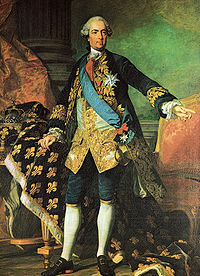
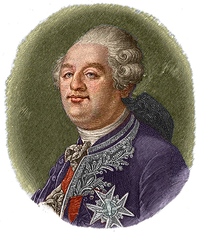
French Revolution
The French Revolution , sometimes distinguished as the 'Great French Revolution' , was a period of radical social and political upheaval in France and Europe. The absolute monarchy that had ruled France for centuries collapsed in three years...
The end of the century saw the birth of the United States, with the help of French ideas and military forces; the declaration of the French Republic in 1792, and the rise of Napoleon Bonaparte, setting the stage for the history of modern France
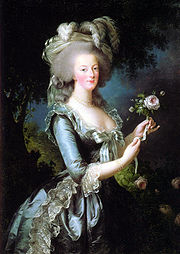
Steam engine
A steam engine is a heat engine that performs mechanical work using steam as its working fluid.Steam engines are external combustion engines, where the working fluid is separate from the combustion products. Non-combustion heat sources such as solar power, nuclear power or geothermal energy may be...
, metallurgy
Metallurgy
Metallurgy is a domain of materials science that studies the physical and chemical behavior of metallic elements, their intermetallic compounds, and their mixtures, which are called alloys. It is also the technology of metals: the way in which science is applied to their practical use...
), and trade with France's colonies in the New World and India. The new class (called The Third Estate) began to challenge the cultural and social monopoly of the aristocracy; French cities began to have their own theaters, coffee houses and salons, independent of the aristocracy. The Rise of the Third Estate culminated in their political victory in the French Revolution.
French thinking also evolved greatly, thanks to major discoveries in in science by Newton
Isaac Newton
Sir Isaac Newton PRS was an English physicist, mathematician, astronomer, natural philosopher, alchemist, and theologian, who has been "considered by many to be the greatest and most influential scientist who ever lived."...
, Watt
James Watt
James Watt, FRS, FRSE was a Scottish inventor and mechanical engineer whose improvements to the Newcomen steam engine were fundamental to the changes brought by the Industrial Revolution in both his native Great Britain and the rest of the world.While working as an instrument maker at the...
, Volta
Alessandro Volta
Count Alessandro Giuseppe Antonio Anastasio Gerolamo Umberto Volta was a Lombard physicist known especially for the invention of the battery in 1800.-Early life and works:...
, Leibniz, Buffon
Georges-Louis Leclerc, Comte de Buffon
Georges-Louis Leclerc, Comte de Buffon was a French naturalist, mathematician, cosmologist, and encyclopedic author.His works influenced the next two generations of naturalists, including Jean-Baptiste Lamarck and Georges Cuvier...
, Lavoisier
Antoine Lavoisier
Antoine-Laurent de Lavoisier , the "father of modern chemistry", was a French nobleman prominent in the histories of chemistry and biology...
, and Monge
Gaspard Monge
Gaspard Monge, Comte de Péluse was a French mathematician, revolutionary, and was inventor of descriptive geometry. During the French Revolution, he was involved in the complete reorganization of the educational system, founding the École Polytechnique...
, among others, and their rapid diffusion throughout Europe through newspapers, journals, scientific societies, and theaters.
Faith in science and progress was the driving force behind the first French Encyclopedia
Encyclopedia
An encyclopedia is a type of reference work, a compendium holding a summary of information from either all branches of knowledge or a particular branch of knowledge....
of Denis Diderot
Denis Diderot
Denis Diderot was a French philosopher, art critic, and writer. He was a prominent person during the Enlightenment and is best known for serving as co-founder and chief editor of and contributor to the Encyclopédie....
and Jean le Rond d'Alembert
Jean le Rond d'Alembert
Jean-Baptiste le Rond d'Alembert was a French mathematician, mechanician, physicist, philosopher, and music theorist. He was also co-editor with Denis Diderot of the Encyclopédie...
. The authority of the Catholic Church was weakened, partly by the conflicts between high and low clergy, partly by the conflict between the State and Jesuits, who were finally expelled from the Kingdom in 1764. The Protestants achieved legal status in France in 1787. The church hierarchy was in continual battle with the Lumieres, having many of their works banned, and causing French courts to sentence a Protestant, Jean Calas, to death in 1762 for blasphemy
Blasphemy
Blasphemy is irreverence towards religious or holy persons or things. Some countries have laws to punish blasphemy, while others have laws to give recourse to those who are offended by blasphemy...
, an act which was strongly condemned by Voltaire
Voltaire
François-Marie Arouet , better known by the pen name Voltaire , was a French Enlightenment writer, historian and philosopher famous for his wit and for his advocacy of civil liberties, including freedom of religion, free trade and separation of church and state...
.
The explorations of the New World and the first encounters with American Indians
Indigenous peoples of the Americas
The indigenous peoples of the Americas are the pre-Columbian inhabitants of North and South America, their descendants and other ethnic groups who are identified with those peoples. Indigenous peoples are known in Canada as Aboriginal peoples, and in the United States as Native Americans...
also brought a new theme into French and European Literature; exoticism, and the idea of the Noble Savage
Noble savage
The term noble savage , expresses the concept an idealized indigene, outsider , and refers to the literary stock character of the same...
, which inspired such works as Paul et Virginie
Paul et Virginie
Paul et Virginie is a novel by Jacques-Henri Bernardin de Saint-Pierre, first published in 1787. The novel's title characters are very good friends since birth who fall in love...
by Jacques-Henri Bernardin de Saint-Pierre
Jacques-Henri Bernardin de Saint-Pierre
Jacques-Henri Bernardin de Saint-Pierre was a French writer and botanist...
. The exchange of ideas with other countries also increased. British ideas were particularly important, particularly such ideas as constitutional monarchy and romanticism, which greatly influenced French writers, particularly in the following century.
The visual arts of the 18th century were highly decorative and oriented toward giving pleasure, as exemplified by the Regency Style and Louis XV Style, and the paintings of François Boucher
François Boucher
François Boucher was a French painter, a proponent of Rococo taste, known for his idyllic and voluptuous paintings on classical themes, decorative allegories representing the arts or pastoral occupations, intended as a sort of two-dimensional furniture...
, Jean-Honoré Fragonard
Jean-Honoré Fragonard
Jean-Honoré Fragonard was a French painter and printmaker whose late Rococo manner was distinguished by remarkable facility, exuberance, and hedonism. One of the most prolific artists active in the last decades of the Ancien Régime, Fragonard produced more than 550 paintings , of which only five...
, Watteau
Antoine Watteau
Jean-Antoine Watteau was a French painter whose brief career spurred the revival of interest in colour and movement...
and Chardin, and portrait painters Quentin de La Tour, Nattier
Jean-Marc Nattier
Jean-Marc Nattier , French painter, was born in Paris, the second son of Marc Nattier , a portrait painter, and of Marie Courtois , a miniaturist...
and Van Loo. Toward the end of the century, a more sober style appeared, aimed at illustrating scenery, work, and moral values exemplified by Greuze
Jean-Baptiste Greuze
Jean-Baptiste Greuze was a French painter.-Early life:He was born at Tournus, Saône-et-Loire. He is generally said to have formed his own talent; this is, however, true only in the most limited sense, for at an early age his inclinations, though thwarted by his father, were encouraged by a...
, Hubert Robert
Hubert Robert
Hubert Robert , French artist, was born in Paris.His father, Nicolas Robert, was in the service of François-Joseph de Choiseul, marquis de Stainville a leading diplomat from Lorraine...
and Claude Joseph Vernet. The leading figures in French music were François Couperin
François Couperin
François Couperin was a French Baroque composer, organist and harpsichordist. He was known as Couperin le Grand to distinguish him from other members of the musically talented Couperin family.-Life:Couperin was born in Paris...
et Jean-Philippe Rameau
Jean-Philippe Rameau
Jean-Philippe Rameau was one of the most important French composers and music theorists of the Baroque era. He replaced Jean-Baptiste Lully as the dominant composer of French opera and is also considered the leading French composer for the harpsichord of his time, alongside François...
, but they were overshadowed by other European composers of the century, notably Vivaldi
Antonio Vivaldi
Antonio Lucio Vivaldi , nicknamed because of his red hair, was an Italian Baroque composer, priest, and virtuoso violinist, born in Venice. Vivaldi is recognized as one of the greatest Baroque composers, and his influence during his lifetime was widespread over Europe...
, Mozart
Wolfgang Amadeus Mozart
Wolfgang Amadeus Mozart , baptismal name Johannes Chrysostomus Wolfgangus Theophilus Mozart , was a prolific and influential composer of the Classical era. He composed over 600 works, many acknowledged as pinnacles of symphonic, concertante, chamber, piano, operatic, and choral music...
Haendel, Bach
Johann Sebastian Bach
Johann Sebastian Bach was a German composer, organist, harpsichordist, violist, and violinist whose sacred and secular works for choir, orchestra, and solo instruments drew together the strands of the Baroque period and brought it to its ultimate maturity...
, and Haydn
Joseph Haydn
Franz Joseph Haydn , known as Joseph Haydn , was an Austrian composer, one of the most prolific and prominent composers of the Classical period. He is often called the "Father of the Symphony" and "Father of the String Quartet" because of his important contributions to these forms...
.
For art and architecture in the 18th century, see French Rococo and Neoclassicism
French Rococo and Neoclassicism
18th-century French art was dominated by the Rococo and neoclassical movements. In France, the death of Louis XIV lead to a period of licentious freedom commonly called the Régence. The heir to Louis XIV, his great grandson Louis XV of France, was only 5 years old; for the next seven years France...
The Philosophes and The Literature of Ideas
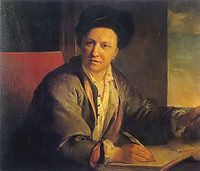
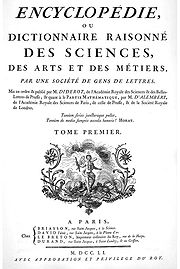
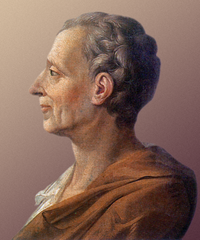
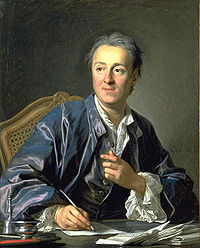
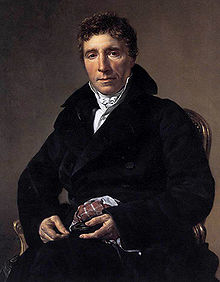
Pierre Bayle
Pierre Bayle was a French philosopher and writer best known for his seminal work the Historical and Critical Dictionary, published beginning in 1695....
and Fontenelle
Bernard le Bovier de Fontenelle
Bernard Le Bovier de Fontenelle , also called Bernard Le Bouyer de Fontenelle, was a French author.Fontenelle was born in Rouen, France and died in Paris just one month before his 100th birthday. His mother was the sister of great French dramatists Pierre and Thomas Corneille...
, (1657–1757), the writers who were called the Lumières denounced, in the name of reason and moral values, the social and political oppressions of their time.
They challenged the idea of absolute monarchy
Absolute monarchy
Absolute monarchy is a monarchical form of government in which the monarch exercises ultimate governing authority as head of state and head of government, his or her power not being limited by a constitution or by the law. An absolute monarch thus wields unrestricted political power over the...
and demanded a social contract
Social contract
The social contract is an intellectual device intended to explain the appropriate relationship between individuals and their governments. Social contract arguments assert that individuals unite into political societies by a process of mutual consent, agreeing to abide by common rules and accept...
as the new basis of political authority, and demanded a more democratic organization of central power in a constitutional monarchy
Constitutional monarchy
Constitutional monarchy is a form of government in which a monarch acts as head of state within the parameters of a constitution, whether it be a written, uncodified or blended constitution...
, with a separation of powers
Separation of powers
The separation of powers, often imprecisely used interchangeably with the trias politica principle, is a model for the governance of a state. The model was first developed in ancient Greece and came into widespread use by the Roman Republic as part of the unmodified Constitution of the Roman Republic...
among the executive, legislative, and judicial branches of government (Montesquieu, Diderot
Denis Diderot
Denis Diderot was a French philosopher, art critic, and writer. He was a prominent person during the Enlightenment and is best known for serving as co-founder and chief editor of and contributor to the Encyclopédie....
, and Rousseau
Jean-Jacques Rousseau
Jean-Jacques Rousseau was a Genevan philosopher, writer, and composer of 18th-century Romanticism. His political philosophy influenced the French Revolution as well as the overall development of modern political, sociological and educational thought.His novel Émile: or, On Education is a treatise...
.) Voltaire
Voltaire
François-Marie Arouet , better known by the pen name Voltaire , was a French Enlightenment writer, historian and philosopher famous for his wit and for his advocacy of civil liberties, including freedom of religion, free trade and separation of church and state...
fought against the abuses of power by the government, such as censorship
Censorship
thumb|[[Book burning]] following the [[1973 Chilean coup d'état|1973 coup]] that installed the [[Military government of Chile |Pinochet regime]] in Chile...
and letters of cachet, which allowed imprisonment without trial, against the collusion of the church and monarchy, and for an "enlightened despotism" where kings would be advised by philosophers.
These writers, and others such as the Abbe Sieyes, one of the main authors of The Rights of Man, became known as the philosophes. They came from the wealthy upper class or Third Estate, sought a society founded upon talent and merit, rather than a society based on heredity or caste. Their ideas were strongly influenced by those of John Locke
John Locke
John Locke FRS , widely known as the Father of Liberalism, was an English philosopher and physician regarded as one of the most influential of Enlightenment thinkers. Considered one of the first of the British empiricists, following the tradition of Francis Bacon, he is equally important to social...
in England. They introduced the values of liberty
Liberty
Liberty is a moral and political principle, or Right, that identifies the condition in which human beings are able to govern themselves, to behave according to their own free will, and take responsibility for their actions...
and equality
Social equality
Social equality is a social state of affairs in which all people within a specific society or isolated group have the same status in a certain respect. At the very least, social equality includes equal rights under the law, such as security, voting rights, freedom of speech and assembly, and the...
which became the ideals of the French Republic founded at the end of the century. They defended the freedom of conscience and challenged the role of religious institutions in society. For them, tolerance was a fundamental value of society. When the Convention placed the ashes of Voltaire in the Pantheon
Panthéon, Paris
The Panthéon is a building in the Latin Quarter in Paris. It was originally built as a church dedicated to St. Genevieve and to house the reliquary châsse containing her relics but, after many changes, now functions as a secular mausoleum containing the remains of distinguished French citizens...
in Paris, they honored him as the man who "taught us to live as free men."
While the philosophes had widely different approaches, they all had as a common objective, both for mankind and for individuals, the ideal of happiness
Happiness
Happiness is a mental state of well-being characterized by positive emotions ranging from contentment to intense joy. A variety of biological, psychological, religious, and philosophical approaches have striven to define happiness and identify its sources....
(bonheur). Some, like Rousseau, dreamed of the happiness of the noble savage, rapidly disappearing; others, like Voltaire, sought happiness in a life of the worldly pursuit of refinement. The philosophes were optimists, and they saw their mission clearly; they did not simply observe, but agitated ceaselessly for the achievement of their goals.
The important works of the philosophes belonged to a variety of different genres, such as the tale illustrating a particular philosophical point;(Zadig
Zadig
Zadig ou la Destinée, is a famous novel and work of philosophical fiction written by Enlightenment philosopher Voltaire. It tells the story of Zadig, a philosopher in ancient Babylonia...
(1747) or Candide
Candide
Candide, ou l'Optimisme is a French satire first published in 1759 by Voltaire, a philosopher of the Age of Enlightenment. The novella has been widely translated, with English versions titled Candide: or, All for the Best ; Candide: or, The Optimist ; and Candide: or, Optimism...
(1759), both by Voltaire
Voltaire
François-Marie Arouet , better known by the pen name Voltaire , was a French Enlightenment writer, historian and philosopher famous for his wit and for his advocacy of civil liberties, including freedom of religion, free trade and separation of church and state...
in 1759); or satire on French life disguised as letters from an exotic country (Lettres persanes by Montesquieu in 1721); or essays (The Spirit of the Laws by Montesquieu in 1748, An Essay on Tolerance by Voltaire in 1763; The Social Contract by Rousseau in 1762; The Supplement to a voyage of Bougainville by Diderot, or The History of the Two Indias by the Abbé Guillaume-Thomas Raynal).
The comedies of Marivaux and of Beaumarchais also played a part in this debate about and diffusion of great ideas. The monumental work of the philosophes was the Encyclopédie ou Dictionnaire raisonné des sciences, des arts et des métiers, the famous Encyclopedia
Encyclopédie
Encyclopédie, ou dictionnaire raisonné des sciences, des arts et des métiers was a general encyclopedia published in France between 1751 and 1772, with later supplements, revised editions, and translations. It was edited by Denis Diderot and Jean le Rond d'Alembert...
of Diderot and d'Alembert, published in thirty-five volumes, with texts and illustration, from 1750 until 1772, accompanied by a large variety of essays, speeches, dialogues and interviews on all aspects of knowledge.
French Theater in the 18th Century
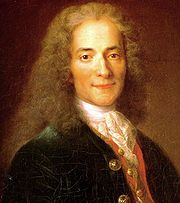
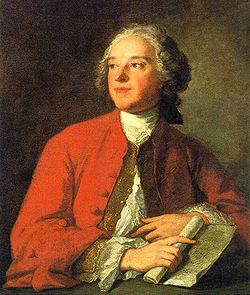
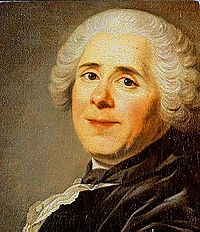
Molière
Jean-Baptiste Poquelin, known by his stage name Molière, was a French playwright and actor who is considered to be one of the greatest masters of comedy in Western literature...
, Racine
Jean Racine
Jean Racine , baptismal name Jean-Baptiste Racine , was a French dramatist, one of the "Big Three" of 17th-century France , and one of the most important literary figures in the Western tradition...
and Corneille
Pierre Corneille
Pierre Corneille was a French tragedian who was one of the three great seventeenth-century French dramatists, along with Molière and Racine...
, continued to exert a great influence on the Comédie-Française
Comédie-Française
The Comédie-Française or Théâtre-Français is one of the few state theaters in France. It is the only state theater to have its own troupe of actors. It is located in the 1st arrondissement of Paris....
, but new life was brought into French theater by the tragedies of Voltaire
Voltaire
François-Marie Arouet , better known by the pen name Voltaire , was a French Enlightenment writer, historian and philosopher famous for his wit and for his advocacy of civil liberties, including freedom of religion, free trade and separation of church and state...
, which introduced modern themes while keeping the classical forms of the Alexandrine
Alexandrine
An alexandrine is a line of poetic meter comprising 12 syllables. Alexandrines are common in the German literature of the Baroque period and in French poetry of the early modern and modern periods. Drama in English often used alexandrines before Marlowe and Shakespeare, by whom it was supplanted...
, as in the play Zaïre
Zaïre (play)
Zaïre is a five act tragedy in verse by Voltaire. Written in only three weeks, it was given its first public performance on 13 August 1732 by the Comédie française in Paris. It was a great success with the Paris audiences and marked a turning away from tragedies caused by a fatal flaw in the...
in 1732, and The Fantaticism of Mohamet in 1741, both of which enjoyed great success. Nonetheless, royal censorship was still active in the theater under King Louis XV and Louis XVI, and, despite his popularity, Beaumarchais had great difficulty getting his play The Marriage of Figaro staged in Paris, because of its political message.
The relaxing of morals under the French Regency brought the return in 1716 of the Comédiens-Italiens, which had been driven out of Paris under Louis XIV. It also saw a period of great theatrical spectacles; crowds went to the theater to see famous actors such as (Lélio
Lelio
Lélio, ou le Retour à la Vie Op. 14b is a work incorporating music and spoken text by the French composer Hector Berlioz, intended as a sequel to his Symphonie fantastique...
, Flaminia, and Silvia
Silvia
Silvia is an Italian female given name of Latin origin, with English-language cognate Sylvia.Silvia is the Roman goddess of the forest and the moon, the sister of Romei, who is greatly trusted as her husband....
…) and to laugh at the characters introduced by the Italian commedia dell'arte
Commedia dell'arte
Commedia dell'arte is a form of theatre characterized by masked "types" which began in Italy in the 16th century, and was responsible for the advent of the actress and improvised performances based on sketches or scenarios. The closest translation of the name is "comedy of craft"; it is shortened...
, such as Arlequin
Arlequin
Arlequin is a free population genetics software. It performs several types of tests and calculations, including Fst, computing genetic distance, Hardy-Weinberg equilibrium, linkage disequilibrium, mismatch distribution, and pairwise difference tests....
, Columbine
Columbina
Columbine is a fictional character in the Commedia dell'Arte. She is Harlequin's mistress, a comic servant playing the tricky slave type, and wife of Pierrot...
and Pantalon. This was the genre used by Marivaux (1688–1763), with comedies which combined a perceptive analysis of the sentiments of love, subtle verbal play, and an analysis of the problems of society, all done through a clever use of the relationship between the master and his valet. His major works include Les Fausses Confidences (1737), le Jeu de l'amour et du hasard (1730), and l'Île des esclaves (1725).
Jean-François Regnard
Jean-François Regnard
Jean-François Regnard , "the most distinguished, after Molière, of the comic poets of the seventeenth century", was a dramatist, born in Paris, who is equally famous now for the travel diary he kept of a voyage in 1681....
et Alain-René Lesage
Alain-René Lesage
Alain-René Lesage was a French novelist and playwright. Lesage is best known for his comic novel The Devil upon Two Sticks , his comedy Turcaret , and his picaresque novel Gil Blas .-Youth and education:Claude Lesage, the father of the novelist, held the united...
(1668–1747) also had great success with comedies of manners, such as Regnard's Le Légataire universel in 1798, and Lesage's Turcaret in 1709. But the greatest author of French comedies in the 18th century was Beaumarchais (1732–1799), who displayed a mastery of dialogue and intrigue combined with social and political satire through the character of Figaro, a valet who challenges the power of his master, who is featured in two major works; le Barbier de Séville
Le Barbier de Séville
The Barber of Seville or the Useless Precaution is a French play by Pierre Beaumarchais, with original music by Antoine-Laurent Baudron. It was initially conceived as a comic opera, and was rejected as such in 1772 by the Comédie-Italienne...
(1775) and le Mariage de Figaro (1784).
The theater of the 18th century also introduced two new genres, now considered minor, which both strongly influenced the French theater in the following century; the "Comedy of Tears" (comédie larmoyante) and the bourgeois drama (drame bourgeois) which told stories full of pathos in a realistic setting, and which concerned the lives of bourgeois families, rather than aristocrats. Some popular examples of these genres were the Le Fils naturel (The Natural Son) by Diderot in 1757; Le Père de famille (The Father of the Family) by Diderot in 1758; Le Philosophe sans le savoir (The Philosopher who did not know he was a Philosopher) by Michel-Jean Sedaine
Michel-Jean Sedaine
Michel-Jean Sedaine was a French dramatist, was born in Paris.- Biography :His father, who was an architect, died when Sedaine was quite young, leaving no fortune, and the boy began life as a mason's labourer...
, (1765); La Brouette du vinaigrier (The Vinegar Cart) by Louis-Sébastien Mercier
Louis-Sébastien Mercier
Louis-Sébastien Mercier was a French dramatist and writer.-Early life and education:He was born in Paris to a humble family: his father was a skilled artisan who polished swords and metal arms. Mercier nevertheless received a decent education.-Literary career:Mercier began his literary career by...
(1775); and La Mère Coupable (The Guilty Mother) by Beaumarchais, (1792).
The 18th century also saw the development of new forms of musical theater, such as the vaudeville
Vaudeville
Vaudeville was a theatrical genre of variety entertainment in the United States and Canada from the early 1880s until the early 1930s. Each performance was made up of a series of separate, unrelated acts grouped together on a common bill...
theater, and the opéra comique
Opéra comique
Opéra comique is a genre of French opera that contains spoken dialogue and arias. It emerged out of the popular opéra comiques en vaudevilles of the Fair Theatres of St Germain and St Laurent , which combined existing popular tunes with spoken sections...
, as well as a new genre of literary writing about theater, such as Diderot's Paradoxe sur le comédien; the writings of Voltaire defending theater actors against the condemnation of the church; and Rousseau's condemnation of immorality in the theater.
The French Novel in the 18th Century


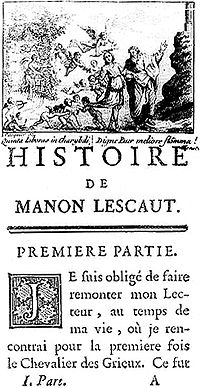
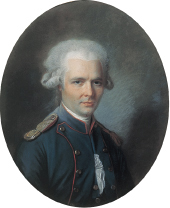
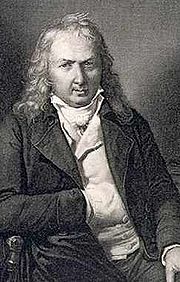
Samuel Richardson
Samuel Richardson was an 18th-century English writer and printer. He is best known for his three epistolary novels: Pamela: Or, Virtue Rewarded , Clarissa: Or the History of a Young Lady and The History of Sir Charles Grandison...
, Jonathan Swift
Jonathan Swift
Jonathan Swift was an Irish satirist, essayist, political pamphleteer , poet and cleric who became Dean of St...
, and Daniel Defoe
Daniel Defoe
Daniel Defoe , born Daniel Foe, was an English trader, writer, journalist, and pamphleteer, who gained fame for his novel Robinson Crusoe. Defoe is notable for being one of the earliest proponents of the novel, as he helped to popularise the form in Britain and along with others such as Richardson,...
.
The novel of the 18th century explored all the potential devices of a novel - different points of view, surprise twists of the plot, engaging the reader, careful psychological analysis, realistic descriptions of the setting, imagination, and attention to form. The texts of the period are difficult to neatly divide into categories, but they can loosely be divided into several sub-genres.
The Philosophical Novel
This category includes the novels of Voltaire, Zadig (1747) and CandideCandide
Candide, ou l'Optimisme is a French satire first published in 1759 by Voltaire, a philosopher of the Age of Enlightenment. The novella has been widely translated, with English versions titled Candide: or, All for the Best ; Candide: or, The Optimist ; and Candide: or, Optimism...
(1759),
and also the later novel, l'Ingénu, (1768) in which Voltaire moved away from fantasy and introduced a large part of social and psychological realism.
The Realistic Novel
This sub-genre combined social realism with stories about men and women looking for love. Examples include la Vie de Marianne (1741), and Le Paysan parvenu (1735) by Marivaux; Manon LescautManon Lescaut
Manon Lescaut is a short novel by French author Abbé Prévost. Published in 1731, it is the seventh and final volume of Mémoires et aventures d'un homme de qualité . It was controversial in its time and was banned in France upon publication...
((1731) by the abbé Antoine François Prévost
Antoine François Prévost
Antoine François Prévost , usually known simply as the Abbé Prévost, was a French author and novelist.- Life and works :...
(1731) and Le Paysan perverti (The Perverse Peasant) (1775), a novel in the form of letters by Nicolas-Edme Rétif
Nicolas-Edme Rétif
Nicolas-Edme Rétif or Nicolas-Edme Restif , also known as Rétif de la Bretonne, was a French novelist. The term retifisme for shoe fetishism was named after him.-Biography:...
(1734–1806). Within this sub-genre is a sub-sub-genre of realistic novels about love influenced by Spanish literature; novels full of satire, a variety of different social milieux, and young men learning their way in the new world. The classic example is Histoire de Gil Blas de Santillane by Alain-René Lesage
Alain-René Lesage
Alain-René Lesage was a French novelist and playwright. Lesage is best known for his comic novel The Devil upon Two Sticks , his comedy Turcaret , and his picaresque novel Gil Blas .-Youth and education:Claude Lesage, the father of the novelist, held the united...
(1715).
The Novel of the Imagination
The novel of the imagination pictured life centuries in the future; L'An 2440, rêve s'il en fut jamais (The year 2440 - dream of all dreams) by MercierLouis-Sébastien Mercier
Louis-Sébastien Mercier was a French dramatist and writer.-Early life and education:He was born in Paris to a humble family: his father was a skilled artisan who polished swords and metal arms. Mercier nevertheless received a decent education.-Literary career:Mercier began his literary career by...
(1771); or stories of fantasy le Diable amoureux (The Devil in Love) of Jacques Cazotte
Jacques Cazotte
Jacques Cazotte was a French author.Born at Dijon, he was educated by the Jesuits. Cazotte then worked for the French Ministry ofthe Marine and at the age of 27 he obtained a public office at Martinique....
(1772).
The Libertine, or Erotic Novel
The libertine, or erotic novel, featured eroticism, seduction, manipulation, and social intrigue. Classic examples are Les Liaisons DangereusesLes Liaisons Dangereuses
Les Liaisons dangereuses is a French epistolary novel by Choderlos de Laclos.Les Liaisons dangereuses may also refer to:* Les liaisons dangereuses , a 1959 film adapted by Claude Brulé and directed by Roger Vadim...
(Dangerous Liaisons) by Pierre Choderlos de Laclos
Pierre Choderlos de Laclos
Pierre Ambroise François Choderlos de Laclos was a French novelist, official and army general, best known for writing the epistolary novel Les Liaisons dangereuses ....
(1782); (Justine ou les Malheurs de la vertu (Justine or the misfortunes of virtue) Donatien Alphonse François de Sade (The Marquis de Sade) (1797); Le Sopha- conte moral ) (The Sopha - a moral tale) by Claude Prosper Jolyot de Crébillon
Claude Prosper Jolyot de Crébillon
Claude Prosper Jolyot de Crébillon was a French novelist.Born in Paris, he was the son of a famous tragedian, Prosper Jolyot de Crébillon. He received a Jesuit education at the elite Lycée Louis-le-Grand...
(1745), and les Bijoux indiscrets (The indiscreet jewels) (1748) and La Religieuse (The Nun) by Diderot (1760).
The Novel of Feelings
The novel of feelings appeared in the second half of the 18th century, with the publication of Julie ou la Nouvelle Héloïse (Julie, or the New Heloise), in a novel in the form of letters, written by Jean-Jacques RousseauJean-Jacques Rousseau
Jean-Jacques Rousseau was a Genevan philosopher, writer, and composer of 18th-century Romanticism. His political philosophy influenced the French Revolution as well as the overall development of modern political, sociological and educational thought.His novel Émile: or, On Education is a treatise...
(1761). It was modelled after the English novel Pamela by Samuel Richardson
Samuel Richardson
Samuel Richardson was an 18th-century English writer and printer. He is best known for his three epistolary novels: Pamela: Or, Virtue Rewarded , Clarissa: Or the History of a Young Lady and The History of Sir Charles Grandison...
, which was the best-selling novel of the century, drawing readers by its pre-romantic depiction of nature and romantic love. Another popular example was Paul et Virginie by Jacques-Henri Bernardin de Saint-Pierre
Jacques-Henri Bernardin de Saint-Pierre
Jacques-Henri Bernardin de Saint-Pierre was a French writer and botanist...
(1787).
The Novel Broken Apart
The romans éclatés, roughly translated "Novels broken apart", such as Jacques le fataliste et son maître (Eng: Jacques the Fatalist and His Master) (1773) and le Neveu de Rameau (Eng: The Nephew of Rameau) (1762) by DiderotDenis Diderot
Denis Diderot was a French philosopher, art critic, and writer. He was a prominent person during the Enlightenment and is best known for serving as co-founder and chief editor of and contributor to the Encyclopédie....
are almost impossible to classify, but resemble the modernist novels that would come a century or more later.
The Birth of the Autobiography in the 18th Century
Literary stories of people's lives were popular throughout the 18th century, with such popular books as la Vie de mon père (Eng: The Life of My Father) (1779) and Monsieur Nicolas (1794) by Nicolas-Edme RétifNicolas-Edme Rétif
Nicolas-Edme Rétif or Nicolas-Edme Restif , also known as Rétif de la Bretonne, was a French novelist. The term retifisme for shoe fetishism was named after him.-Biography:...
, but the success of the century was Jean-Jacques Rousseau
Jean-Jacques Rousseau
Jean-Jacques Rousseau was a Genevan philosopher, writer, and composer of 18th-century Romanticism. His political philosophy influenced the French Revolution as well as the overall development of modern political, sociological and educational thought.His novel Émile: or, On Education is a treatise...
, who founded the genre of the modern autobiography with les Rêveries du promeneur solitaire (The dreams of a solitary walker) in 1776, and Les Confessions in 1782, which became the models for all novels of self-discovery.
French Poetry of the 18th Century
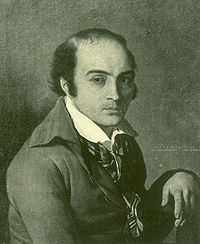
Jacques Delille
Jacques Delille was a French poet and translator. He was born at Aigueperse in Auvergne.-Life:He was an illegitimate child, and was descended by his mother from the chancellor De l'Hôpital. He was educated at the College of Lisieux in Paris and became an elementary teacher...
(1738–1813), for les Jardins (Eng: The Gardens), in 1782; and Évariste de Parny (1753–1814) for Élégies in 1784, who both contributed to the birth of romanticism and to the poetry of nature and nostalgia.
The poet of the 18th century best-known today is André Chénier
André Chénier
André Marie Chénier was a French poet, associated with the events of the French Revolution of which he was a victim. His sensual, emotive poetry marks him as one of the precursors of the Romantic movement...
(1762–1794), who created an expressive style in his famous la Jeune Tarentine (Eng: The Young Tarentine) and la Jeune Captive (Eng: The Young Captive), both published only in 1819, long after his death during the Terror
Reign of Terror
The Reign of Terror , also known simply as The Terror , was a period of violence that occurred after the onset of the French Revolution, incited by conflict between rival political factions, the Girondins and the Jacobins, and marked by mass executions of "enemies of...
of the French Revolution
French Revolution
The French Revolution , sometimes distinguished as the 'Great French Revolution' , was a period of radical social and political upheaval in France and Europe. The absolute monarchy that had ruled France for centuries collapsed in three years...
.
Fabre d'Églantine
Fabre d'Églantine
Philippe François Nazaire Fabre d'Églantine , commonly known as Fabre d'Églantine , was a French actor, dramatist, poet, and politician of the French Revolution.-Early life:He was born in Carcassonne, Aude...
was known both for his songs, such as Il pleut, il pleut, bergère) (Eng: It's raining, shepherdess) and for his participation in the writing of the new French Republican Calendar
French Republican Calendar
The French Republican Calendar or French Revolutionary Calendar was a calendar created and implemented during the French Revolution, and used by the French government for about 12 years from late 1793 to 1805, and for 18 days by the Paris Commune in 1871...
created during the French Revolution
French Revolution
The French Revolution , sometimes distinguished as the 'Great French Revolution' , was a period of radical social and political upheaval in France and Europe. The absolute monarchy that had ruled France for centuries collapsed in three years...
.
Other Genres of 18th Century French Literature
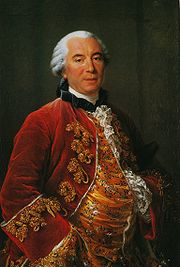
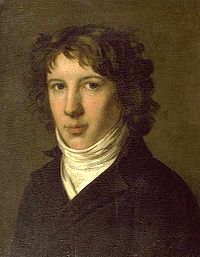

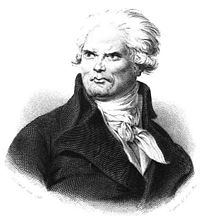
- The genre of modern art criticism was launched by Diderot in Salons, in which he analyzed the way emotions could be created by works of art, using the example of the feelings inspired by the poetic ruins painted by Hubert RobertHubert RobertHubert Robert , French artist, was born in Paris.His father, Nicolas Robert, was in the service of François-Joseph de Choiseul, marquis de Stainville a leading diplomat from Lorraine...
.
- Georges-Louis Leclerc, the Count of BuffonGeorges-Louis Leclerc, Comte de BuffonGeorges-Louis Leclerc, Comte de Buffon was a French naturalist, mathematician, cosmologist, and encyclopedic author.His works influenced the next two generations of naturalists, including Jean-Baptiste Lamarck and Georges Cuvier...
, popularized the scientific discoveries of his century with the massive Histoire naturelle (Eng: Natural History), published with great success between 1749 and 1789.
- During the French Revolution, political speeches became a popular genre of literature with the publication of the speeches of such talented orators as Honoré Gabriel Riqueti de Mirabeau, Louis de Saint-JustLouis de Saint-JustLouis Antoine Léon de Saint-Just , usually known as Saint-Just, was a military and political leader during the French Revolution. The youngest of the deputies elected to the National Convention in 1792, Saint-Just rose quickly in their ranks and became a major leader of the government of the French...
, Georges Jacques Danton and Maximilien de Robespierre.

